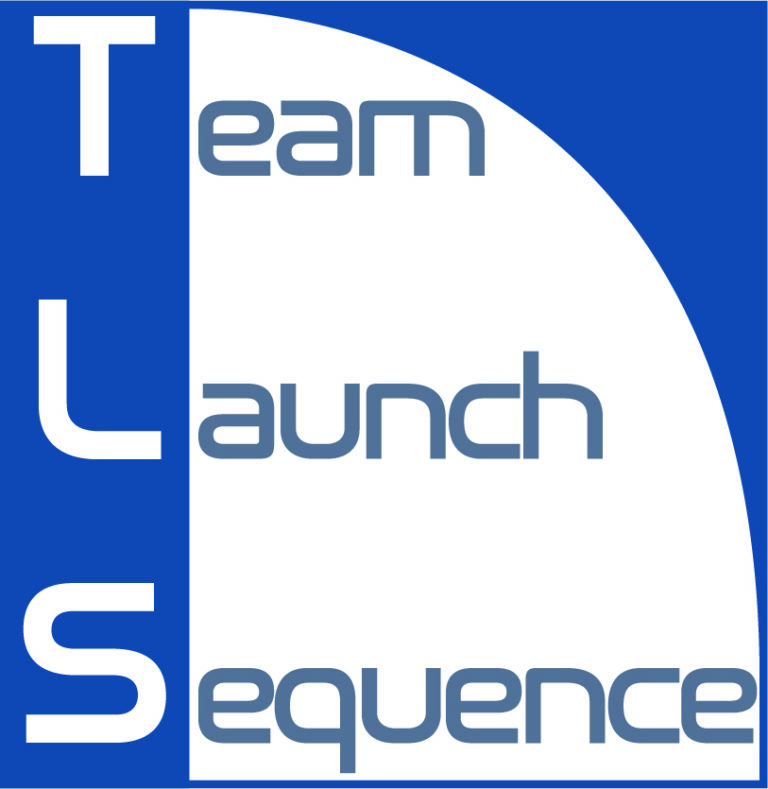
For Teams that are:
-
Newly formed
-
New to agile
-
Looking for a boost
The Humanizing Work Team Launch Sequence gets you aligned, focused and collaborating more effectively in two weeks.
Is Your Team High Performing?
We all want high-performing teams, and most of us have had some success in helping cultivate them. Unfortunately, most of us have also experienced the opposite, where a team that should succeed really struggles, often for way too long.
In the worst case scenario, they never achieve their potential.
We’ve helped create hundreds of high performing teams. And we’ve learned what conditions set those teams up for success. When these elements are present, teams almost always perform. When they are absent, teams struggle to perform:
- Shared ways of working
- Alignment on a team vision
- A backlog structured for collaboration vs. coordination
- Frequent experimentation with better ways to collaborate
These elements are hard to create!
Most of time, teams push back on spending time on this type of improvement. For good reason! They are under high pressure to get their work done, there are schedules and deadlines to handle!
None of those elements come for free. You have to invest time, energy, and expertise to create them. And time spent on those elements is time spent AWAY from the work the team is being paid to do. We all know that we should spend time “sharpening the saw”, but when there’s a huge quota of cut wood to deliver every single day, it’s tough to prioritize those improvement efforts.
Teams address this challenge in one of three ways.
- They give up on trying to make significant improvement.
- They block a day or two away from their normal work to do team building.
- They squeeze in small slices of team building where they can.
The first approach is a tragedy. We’re devoting a huge portion of our waking lives at work, and giving up on trying to make it more effective and rewarding is simply not an option.
The second approach has the upside of making some great progress, if done well. Popular team building activities like ropes course and escape rooms don’t actually create the four elements listed above. The downside is that even if a team spends some concentrated time working on the first three, they are all guesses at the best way to work. The fourth element, frequent experimentation, simply takes time.
The third approach often ends up being ad-hoc, and improvement gets squeezed out of agendas and plans in favor of “getting some work done”. When done well, teams start seeing real improvement, often after three to six months.
The TLS Breakthrough
The Team Launch Sequence is the result of a key breakthrough. We discovered that team improvement is much less about how long the team has been together, and much more about how frequently they had experimented with better ways to work together. So we decided to test the limits of that with a few teams by doing One Day Sprints. Sounds crazy right?
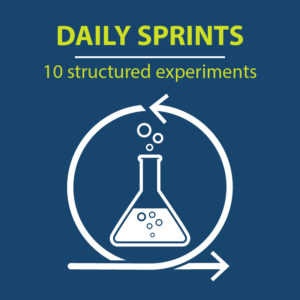
Well, it was a bit crazy! During daily sprints, the team does their standard work. They start each day by brainstorming at least one work item where they can actually collaborate. They check in mid-day on the progress on those items, and at the end of the day do a very quick “Sprint Review” for the items that were picked. They then do a very quick retrospective to pick an experiment for how to collaborate more effectively the next day.
And it worked! By the end of two weeks of one day sprints, those early teams had made huge progress in their ability to collaborate and deliver high value work. It was like a typical scrum team that had been doing good retrospectives for 3-6 months.
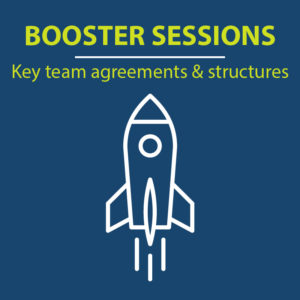
Over time, we incorporated a set of booster sessions into the two weeks of daily sprints:
- Team Vision
- Team Working Agreement
- Backlog Tuneup
- TLS retrospective to decide what patterns the team wants to bring into their more standard cadence.
This structure allows the team to continue delivering real work while rapidly experimenting with new and better ways to collaborate and creating the key elements for team success.

During the TLS, the team works in a Miro board which provides everything you need to get the most out of daily sprints and the boosters. At the center of the board is a simple organizer for the daily sprints, and the four booster sessions are organized around the daily sprint organizer. Each section of TLS includes videos of Richard and Peter explaining the content and how to use it.

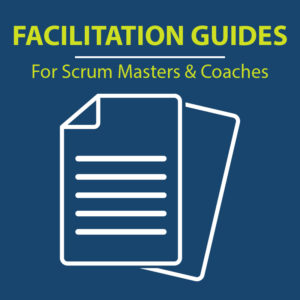
The TLS is facilitated by a Scrum Master, Coach, or other leader in the organization that has a firm grounding in agile practices and is an experienced facilitator. But they don’t need to know the TLS content well; we’ve created a full featured facilitation guide. The guide gives detailed instructions for each component of the TLS, along with video explanations from Richard and Peter.
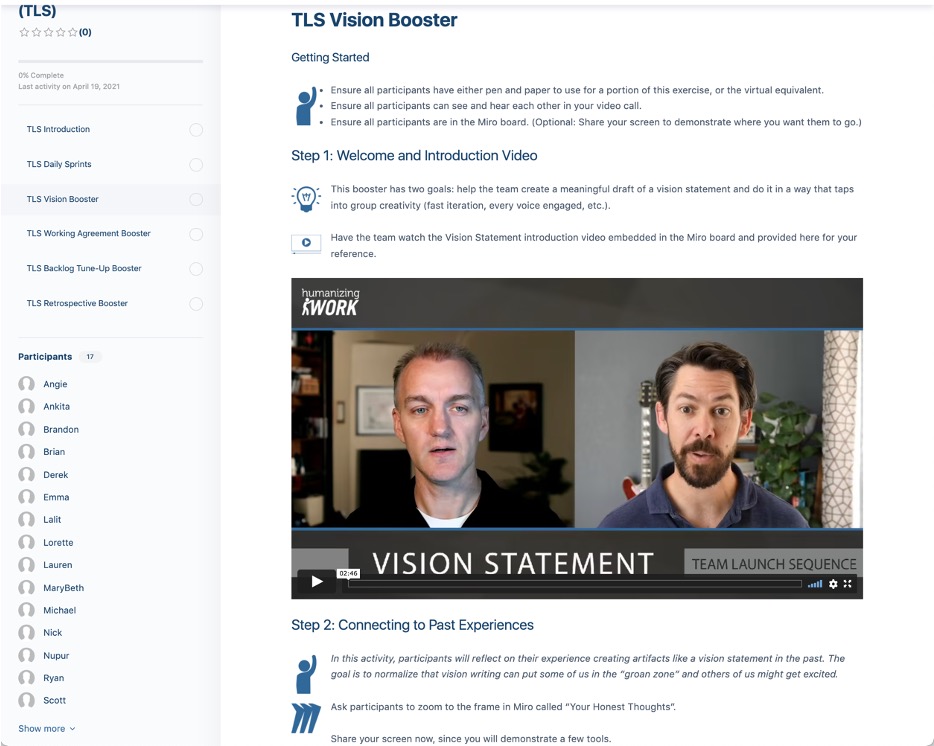
Scheduling the TLS components
Booster Sessions are interleaved with the team’s daily work. We typically recommend a rough schedule as illustrated below, where the team spreads the Vision, Working Agreement, and Backlog Tune-up booster sessions throughout the two weeks and concludes the TLS with the Retro booster.
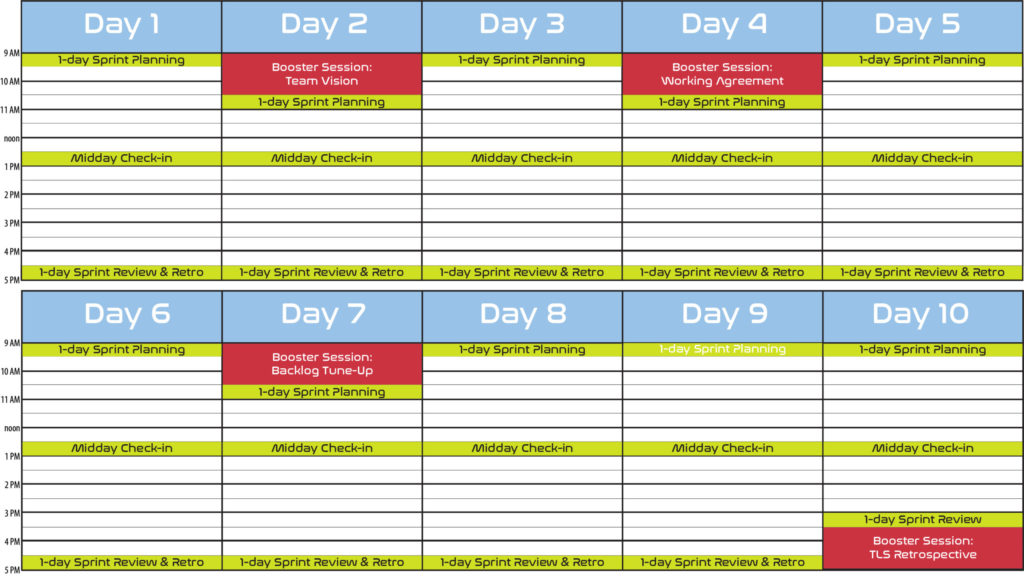
Facilitators should plan on spending a few hours studying the facilitation guide prior to kicking off the TLS. Depending on their experience and comfort improvising, some facilitators have reported needing 30 minutes for each component, while others have wanted to spend a couple of hours really internalizing the components and our facilitation structures for each so that they really knew it cold.
Teams should schedule the TLS with an awareness that this is an investment in time and focus. While they will be working on their real backlog(s), we are asking them to experiment rapidly with new things, and not every experiment results in an improvement. That’s why it’s an experiment! So, teams often choose to make a smaller commitment on their deliveries during the two weeks of TLS. The investment is well worth it. A past TLS client recently told us that some team members approach him and asked if they could “do some TLS days”. This was six months after the focused TLS. They wanted to do some rapid experimentation because they had seen how it helped them break through on some critical collaboration challenges.